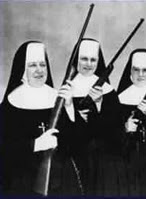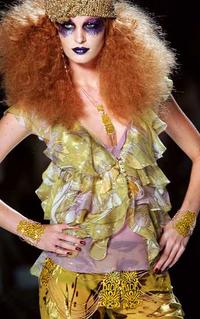Dark and Dreary? Nunsense!!

Well we all know sistas can work the runway as well, if not better, than anyone. But then, we're usually referring to charming little numbers like Lakisha Jones when we use the term "sistas".
According to Silvia Evangelisti, author of the soon-to-be-released "Nuns: A History of Convent Life", 16th and 17th century sistas in the habit, ie nuns, were just as glam. Far from the pious, spartan, somewhat lonely lifestyles we usually associate with the cloistered, many of these ladies were fully torqued. They were independent, jolly, productive, and determined. They wrote, painted, put on theatrical shows, sang, and ran their own communities. Many enjoyed political influence through well connected family members and friends in the aristocracy. Others helped shepherd the commoners by giving lessons at school, conducting delinquent youth hip-hop/R&B bands, campaigning against the Kyoto pact, etc.
And, of course, they were fashionistas. Part of the reason young girls flocked to convents in Florence and Milan (half of all female elites in Florence lived in convents between 1500 and 1800) was because that was where all the best artisans lived. Although confined to habits and burqa-esque sackcloth most of the time, many were able to commission work from tailors and fashion houses in the city. They had tapestries on their walls, embroidered pillows, books and guitars. A Mother Superior in Milan even had her own set of designer hunting rifles!
Evangelisti argues that the modern, liberated female owes a huge debt of gratitude to the convents of old. As the only place a pre-industrial western European woman could avoid the yoke of a husband and family, get educated, and learn to bust a groove on the turntables, the convent was essentially the birthplace and repository of women's lib for centuries.
From this we can draw two conclusions, both somewhat paradoxical in nature:
(1) The proliferation of Christianity across the developing world may be working wonders for cultivating global gender parity.
(2) Westerners should both lament the fall in female vocations in their own countries and consider a law mandating that all militant dykes don some uber-glam sackcloth and join a convent.
Afro

An afro, sometimes called a "del toro" or shortened to "fro (desiac)", is a hairstyle in which the hair extends out from the bare head like a halo, cloud or cheeseball. This may or may not include wearing such afros long, to several times the diameter of the cranial region. An afro usually requires curly hair and often, but not always, "Afro textured hair", which typically people of indigenous African descent naturally have, hence the nahm.
Archaeologists agree that the ancient Egyptians were known at times to wear their hair "wooly". Thus, their culture is an example of a "Fro-phillic" or "Pro-Fro" society. The ancient Nerubs, on the other hand, did not tolerate afros of any kind, and have been classified as "Fro-Phobic" or "Anti-Jemima".
Anyone of any ethnic background, however, is capable of acquiring an afro if they have curly hair and enough willpower. The naturally kinky, or those endowed with spiraling, tightly coiled curls (not to be confused with bubes) can achieve an afro by first braiding the hair, then separating the coils using an afro pick. The afro pick is a fickle thing, resembling a narrow comb with long, widely spaced teeth, and therefore should only be used under proper supervision.
In short: if you can rock the afro, rock the afro. But don't say you weren't warned.
Fashionisms: Part Deux

A) "What a fabulous melage, wasn't it?! Simultaneously space-age, and retro...and Barbie! And the genius, really, right there...don't you think? In that simultaneity, I mean. It really is. I mean, it really, really is. Gorgeous."
B) "Velvet. Victorian. Almost like a re-printed tart. The kind you'd find in some backwater like Sheffield. Ruffled necklines that we saw collapsed, but somehow not lazy. I'm not quite sure how he pulled it off, but it was very modern, very sheik, very sexy".
C) "Oh he's SUCH a nomad, isn't he? But somehow a bit of a post-modern cowboy at the same time. And did you notice the corsets? The way the ripples almost descended off the bodice. I think it was a kind of commentary on the Victorian ideal versus the late 21st century 'Golgi' body".
D) "The message here is: fasteners. It's about owning your own destiny. It's about "pinning up" instead of "putting up".
E) "How can I put this to you in a way you'll understand...Throwing a pebble into a pond is a very violent act. But it's still feminine, and beautiful. Much more so than one might imagine".
Fashionisms

Match the picture above with the correct quote
=================================
N.B these should all be read with a posh British accentA) "Sort of Gothic, with a hint of melodrama and executed with a poise that was almost...revolutionary".
B) "The message here is: bags. And when I say bags I don't just mean 'bags'. I mean full, floppy, full-bodied, hole-in-one, grandpa's-hernia, character pieces that really do say something about who we are, where we've been, and the problem of global warming".
C) "There was something Gaussian about it. Something like a silent scream. Like Juliette or Guinevere or Strom Thurmond before he really came into his own. I loved it. Absolutely gorgeous".
D) "Well, what you notice immediately are the references to the French revolution. He's hinting at high collars and crosses and using subtleties in the fabric that immediately make you think of...oh, I don't know... gooseberry jam".
E) "What I realized today is: he's not a designer, he's a conjurer. A dream maker. Someone who can almost see the unseen, weave mist into fabric, make The Economist read like Playboy. Do you know what I mean?"
F) "There really aren't any suitable adjectives in English to describe what we just saw. One can only really draw on the German here. Aufbazen. Yes, that seems to fit best. It was aufbazen. Almost iridescently so!"
Oaky Love

Alright so I've been deriding amateur wine connoisseurs for years now. People that smell the cork, swirl the wine in the glass, examine the wine's "legs" and ascribe all manner of completely random adjectives to the wine's flavour (or "texture", "body" etc). One of the most often used of these adjectives is "oaky". As in, "I do declare! Hints of black cherries with an oaky well-roundedness"
. Well, maybe not that pretentious; I tend to avoid drinking with people that take it that far, but there have been a few.
So today when I picked up a new bottle of wine at the LCBO, I wasn't expecting anything approaching oaky. I mean, I don't even believe in oaky. I'd like to. But only in the same way I'd like to believe that the Notorious B.I.G is still living large, pimping hoes somewhere in the Caribbean.
Imagine my surprise then, when I poured a glass and discovered that there was a very distinct flavour of wood in the wine I had selected. "Hmm...it's almost...
...could it be?"
I grabbed the bottle and read the label on the back: "Full-bodied, firm, and tannic with boisonberry and black currant flavours". Blah blah blah, the usual trash. And then, there it was:
"Oak barrel aging mellows the wine, allowing it to be enjoyed now or cellared to enhance its qualities".
Booyak. I almost felt like Colombus.




